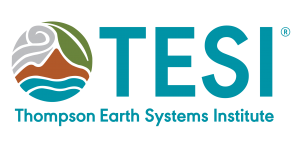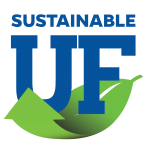

January 2022
Written by Astrid Rojas, Office of Sustainability Intern, and Lauren Stefan, Office of Sustainability Design & Marketing Assistant, in collaboration with the UF Thompson Earth Systems Institute

Happy New Year! Astrid and Lauren with Sustainable UF here!
2022 is underway and many people are exploring new goals and resolutions for the year ahead. One of the sustainability-related resolutions that we often hear is to become a more informed consumer. People want to make sure their money is going to companies who align with their values, including a commitment to reducing their impact on the environment.
Admittedly, this is a challenging goal. Even if we are committed to reducing new purchases through reuse and repurpose, most of us will find ourselves shopping for new goods to a certain extent. Companies across the globe use various messages and images to market their products but understanding clear connections to environmental impact can feel murky and daunting.
In this Action of the Month, we will walk through the concept of greenwashing and the ways you can start to differentiate a legitimate eco-friendly company from an unproved sustainable marketing claim. Finding businesses that share your sustainability values and put these values into practice is possible! Together, we will become highly informed consumers.
What Exactly Is Greenwashing?
The term greenwashing was coined in an essay by environmentalist Jay Westerveld in 1986 when he noticed that a hotel resort placed notices in rooms promoting the reuse of towels to allegedly reduce ecological damage. However, that same hotel resort in Fiji was undergoing massive beach expansions, in turn damaging the bordering marine environment and coral reefs. The hotel was advertising the sustainable reuse of towels to divert attention away from the other damage they were doing to the environment.
Greenwashing can therefore be defined as an unsubstantiated claim that deceives consumers into believing that a company’s products are environmentally-friendly when that is likely not the full story. Unfortunately, misleading advertisements and hypocritical claims like the hotel eco-towels have grown to be commonplace in business and marketing models since then.
Why do companies use greenwashing techniques? Well, it turns out that the majority of people actually do prefer to buy a greener product when available. Recent data shows that 61% of consumers look for energy-efficient labels when they make purchases and 68% want to support brands that reduce environmental impact. This is great news! The flip side is that businesses have a difficult time getting consumers’ attention in today’s advertising-centric society and may approve marketing that emphasizes or overstates sustainability claims instead of investing in lasting sustainable business practices.
5 Common Examples of Greenwashing in Our Daily Lives
To become more informed consumers, we need to start off with a thorough understanding of what greenwashing looks and sounds like. Greenwashing instances can show up on packaging, social media, commercials, newsletters, and more. Let’s review five common examples of greenwashing.
Lofty Claims Without Proof
Companies often describe their products with words and phrases like natural, biodegradable, green, eco-friendly, and vegan. While these labels are sometimes accurate, they could also be intentionally misleading. There are no governing bodies that regulate the use of many words like these in messaging. Reading the entire product label or current label regulations can help provide a better understanding of the item you are purchasing.
Sustainable Fashion Lines
Sustainable is a very broad, general term. In the world of fashion, most sustainability labels are all relative. Sustainability statements for clothing are made in comparison to the industry norms, which have traditionally been quite detrimental to the environment.
In recent years, it has been a trend for fashion companies to produce a sustainable line within their larger brand. This can be problematic as advertisements will likely lead you to believe that this green approach transfers over to the entire brand. Be skeptical of fast fashion companies in particular. Large-scale changes to clothing production take time, so there is a strong chance they are still causing a negative environmental impact overall.
Unethical Production & Supply Chains
As outlined above, the clothing and products we buy can have environmental impact beyond the item itself. For all manufacturing processes, there is an entire global supply chain to review for greenwashing. There is the factory worker who made it, how much they were paid and under what conditions, where the materials for the product were sourced, and how it was physically transported. There are countless transgressions and, increasingly, corporations are called out for unethical infringements of labor rights. Brands that are undertaking the task of innovating their supply chain, paying fair wages, and limiting non-polluting materials will usually have that information displayed clearly on their website.
Symbolic Action
Symbolic action is exactly what Westerveld observed when he coined the term greenwashing in relation to the reuse of hotel towels. Businesses will use a small, positive action or claim to promote an environmentally-friendly image of the company. These actions are particularly difficult to navigate. The actions themselves could have tangible positive environmental impact or be the first steps for a company working to shift their practices and culture. So it’s important to look for businesses that “walk the talk” and advocate for long term commitments to sustainability.
Environmental Imagery
Picture a single-use plastic water bottle. What images and colors do you see on the bottle?
The vision we have is of nature scenes laden with mountains and glistening springs. The coloring is primarily blue and green, tones associated with earth and sustainability. Yet the product itself is one of the most unsustainable items we encounter on a daily basis as modern consumers!
Some brands have featured green leaves or trees on packaging to imply sustainable practices or recycling. Others have even printed small, meaningless images to resemble logos for environmental certifications!
Identifying Sustainable Business Practices
There is a lot to look out for! Sure, certain companies may make environmental or sustainability claims that are less than 100% clear or honest. But as consumers, we hold the power of choice and can find the information we need to uncover which claims can be trusted and which ones are greenwashing.
Luckily, more and more businesses have a genuine interest in corporate social responsibility. It suggests that businesses are looking to be accountable to consumers and better align their business purposes to environmental and social concerns. The hope is that, along with companies committing to corporate social responsibility, consumers can make informed purchases that encourage businesses to leave greenwashing practices behind.
Reliable Resources for Evaluating Companies
Check out these trusted sources for evaluating green business practices! They make it easy to continue on the journey towards becoming a highly informed consumer.
Find A B Corp
The non-profit B Lab hosts a global directory of B Corporations. B Corporations are companies that deliver on both social and environmental high standards. They are also certified on their accountability and transparency.
Green Business Bureau
The Green Business Bureau provides insight into effective, ethical, and transparent reporting methods that businesses can use to attempt to quantify their sustainability practices. This is an excellent resource for existing businesses as well as those wanting a more in-depth look at the hard data behind sustainability progress.
Fashion Transparency Index
The fashion industry is complex – true fashion supply chain sustainability is next to impossible to achieve. As a result, the organization Fashion Revolution focuses on reviewing the transparency of 250 of the world’s largest brands and retailers. They complete an annual ranking known as the Fashion Transparency Index that analyzes the social and environmental policies and impacts in the companies’ operations and supply chains.
Additionally, websites like Good On You and Done Good share easy-to-read details about companies’ stances on issues like labor conditions, material sourcing, and waste. Finally, consider brands that offer lifetime repairs and warranties so you know your purchase will last.
PETA’s Cruelty-Free Directory
A search through the Beauty Without Bunnies directory from PETA will help you quickly discover the product testing practices behind your favorite cosmetic brand and personal-care products.
USDA Organic Food Standards
The USDA organic label can only be used when foods meet specific federal guidelines. These guidelines incorporate factors such as soil quality, pest and weed control, production, and animal raising practices. Learn more about verifying organic food labels from the USDA.
Eco Labels for Green Hotels & Other Services
Services such as hotels have caught a lot of flack in recent years for practices such as those that spurred the term greenwashing. Now, credible programs such as the Florida Green Lodging Program exist to help evaluate hotels’ commitment to protecting the state’s natural resources. The EPA provides further insight into green hotel standards. You can inquire about energy consumption, water use, and LEED buildings when researching other service industries.
Small steps for a More Sustainable Future
With some extra research and analysis, we can easily make purchasing choices that align with our sustainable goals. These small steps we take to find and support companies that uphold our sustainability expectations lead us toward a more sustainable future. When we opt to support truly sustainable companies, we demonstrate to all corporations that ethical and transparent business practices are a real possibility.
Interested in more Action of the Month ideas? Visit the Highlight Stories section on our website!
